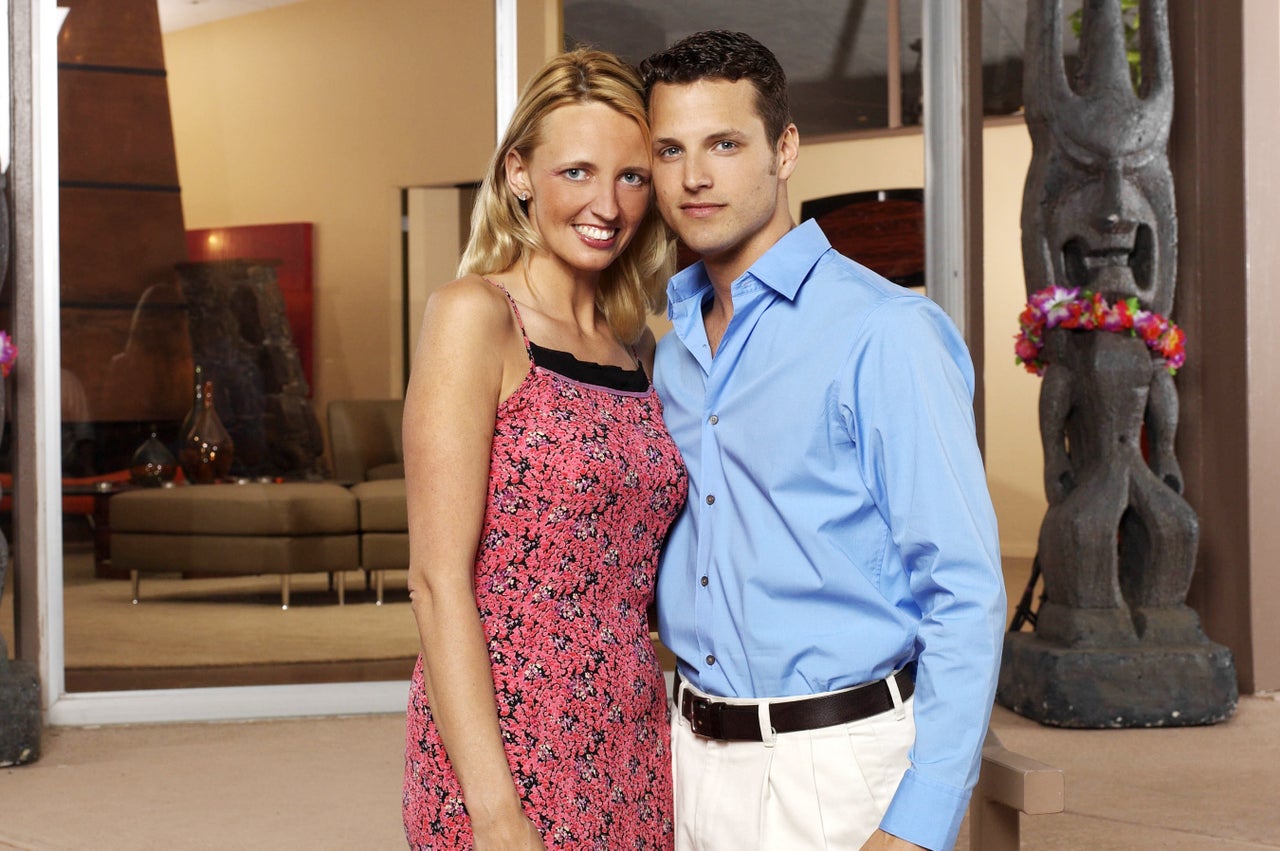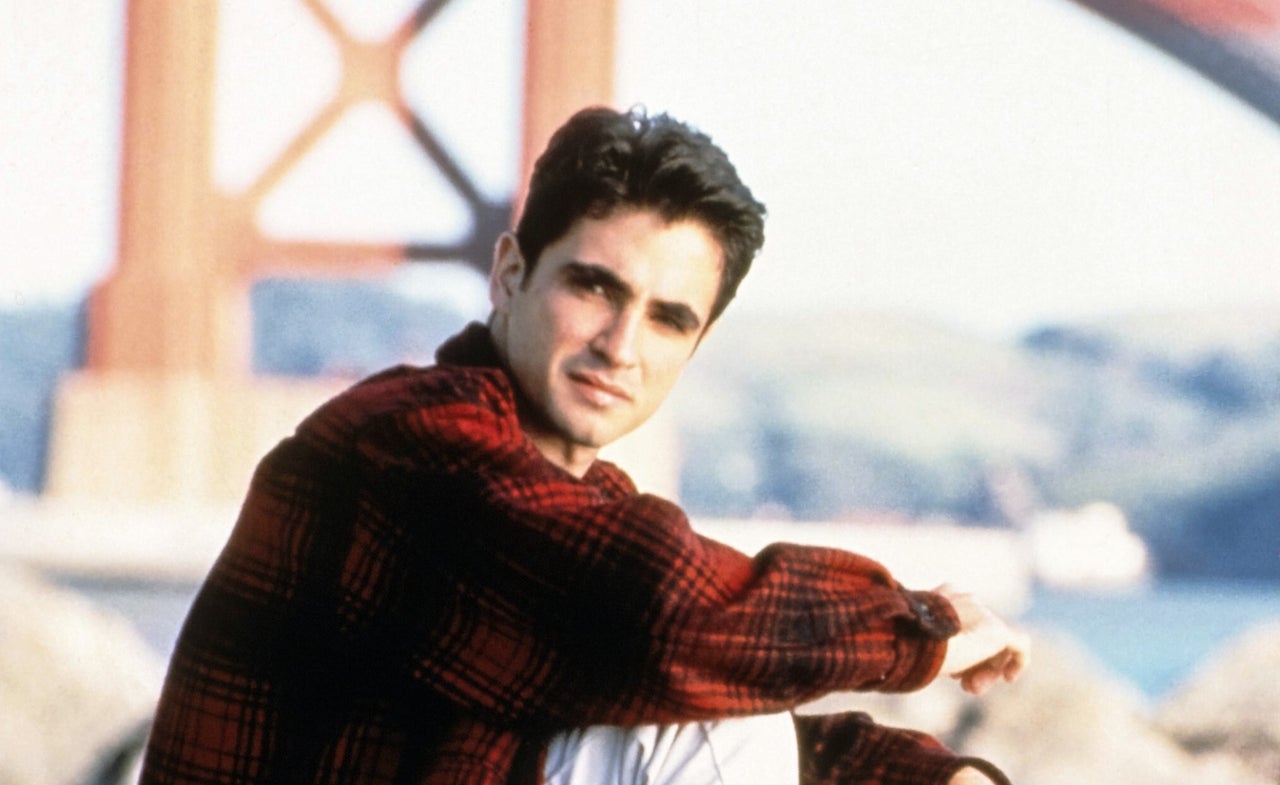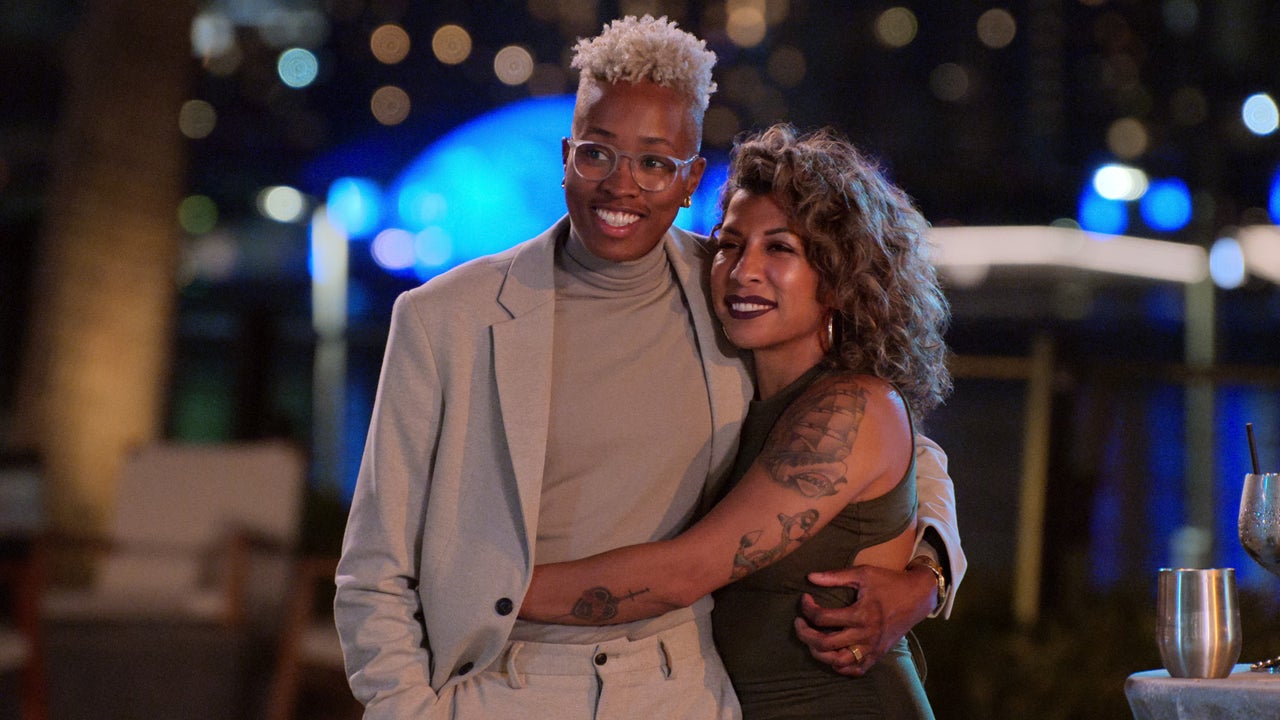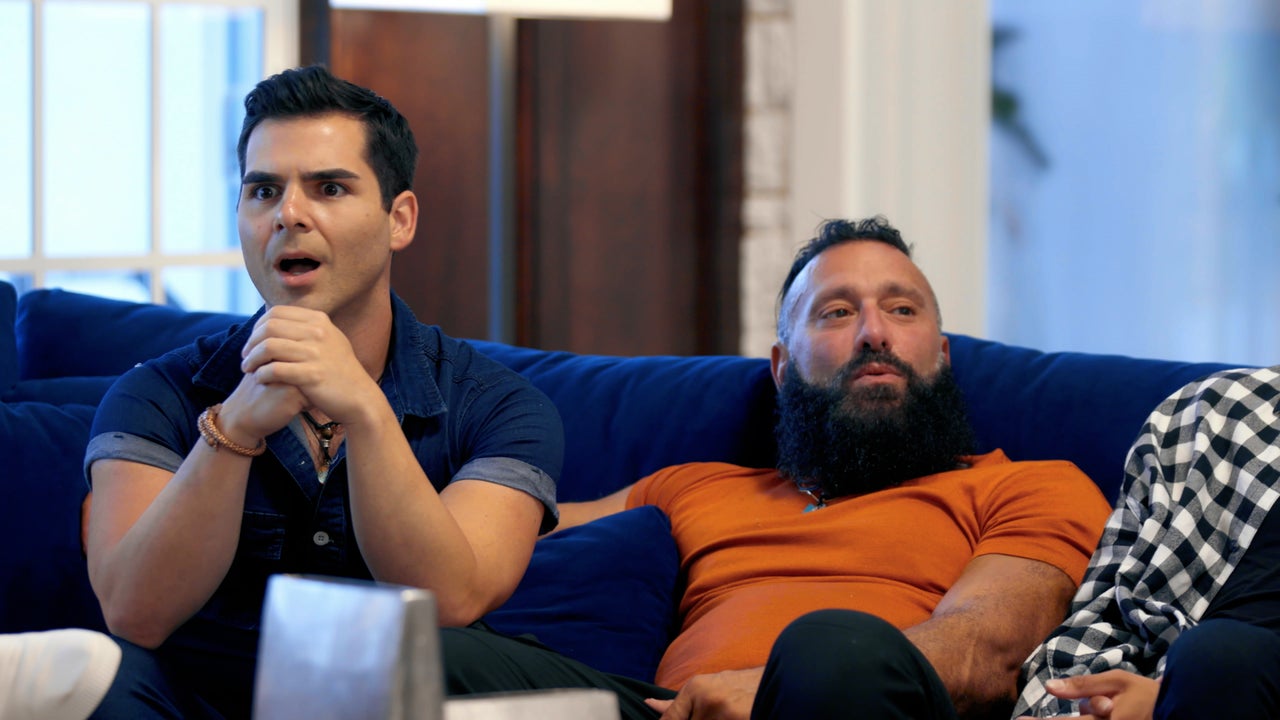In the premiere episode of “Boy Meets Boy,” host Dani Behr told the audience a piece of information that none of the men in its cast knew when they signed up: Half of the 14 suitors vying for the affection of human resources professional James Getzlaff were actually straight, and that if they deceived Getzlaff well enough to win, they could walk away with $25,000.
“Boy Meets Boy,” the very first same-sex dating show, which premiered 20 years ago this summer, was widely derided for its twist. Entertainment Weekly labeled it one of the 20 worst reality TV shows ever and characterized its twist as “cruel” and “offensive.” Despite this dubious distinction, the show’s executive producer, Douglas Ross, who founded Evolution Media, the production company behind “Vanderpump Rules” and “The Real Housewives of Beverly Hills,” called the show “daring and well-executed” in an interview with HuffPost and said that it is one of the shows he’s still most proud of.
The twist, Ross says, is what appealed most to the execs over at Bravo, which was looking to reinvent itself and move beyond its somewhat stodgy image as a channel dedicated to the fine arts. The heart of that experiment, he adds, was that it flipped a societal script on its head: For the first time, even if only for two weeks in Palm Springs, contestants would live in a world where straight men were closeted and queerness was the norm.
“If you look at it in the right frame of mind and if you have a sense of humor, it’s actually very progressive and it’s a great social experiment,” Ross said, adding he was “surprised” a sector of the audience was offended by it. “I would still pitch that show.”
“Boy Meets Boy” was pitched as a gay version of “The Bachelor,” which premiered that January. It debuted when reality TV, like me, was entering something of a formal adolescence.
The suitors on screen, who were mostly white and fit, bore no resemblance to my 14-year-old self, but the show still left me slack-jawed. More real queer people were being shown on TV: “Queer Eye” had debuted just two weeks prior, and “The Ellen DeGeneres Show” would premiere that September. But “Boy Meets Boy” registered differently for me. I saw a group of men dating each other on TV, making the possibility that it might happen to me somewhat nearer than it had been before.

Casual cruelty was something of a hallmark of early 2000s culture (see the treatment of cultural figures such as Britney Spears, Anna Nicole Smith, Pamela Anderson and others). Earlier in 2003, “Joe Millionaire,” another show that hinged on a deceit-infused twist, debuted to great cultural chatter. “America’s Next Top Model,” which was willing to put contestants in potentially uncomfortable situations for ratings, had debuted on UPN just a couple of months earlier. Shows like “The Osbournes,” “The Anna Nicole Smith Show” and “The Surreal Life” proved that the genre was willing to drop its docuseries-style roots and lampoon its main characters, whether they be celebrities or not.
“Boy Meets Boy” was swallowed up by the zeitgeist in a similar way: In episode 5, Getzlaff tells his best friend, Andra Stasko, who was brought along to help guide him in his decision-making, about the show’s twist. The moment became widely lampooned; parody program “Mad TV” dedicated no fewer than five separate skits to Andra and her honest reaction to being told she and James were being lied to. The skits usually involved Michael McDonald flailing around the set yelling, in a nod to Andra’s own words, “This is bullshit!”
Just as Andra was put off by the twist, so were the contestants, according to Matt Hendry, who was a “mate” on “Boy Meets Boy” and eliminated in its third episode.
“We actually got really pissed off,” he told HuffPost. “We agonized over pretending to be straight for so many years to then come out and go on a TV show that we thought was going to be elevating the struggles of gay dating and being gay in society.”
He continued, “I wish it had just been 14 gay guys.”
Proposing such a tweak to the show’s format illuminates an obstacle that queer reality shows, especially dating shows, have always had to surmount: How do you make a show that fairly represents a diverse, enormous community while also making something entertaining? On some level, the question is unfair; no one show can represent the broad LGBTQ+ spectrum, nor should reality TV only be judged through the lens of representation, just as shows about straight people are not tasked with representing the cishet community.
“Reality TV has been telling stories long before scripted media started to catch up.”
- Dr. Danielle Lindemann, author of “True Story: What Reality TV Says About Us”
It’s an especially thorny question given that reality TV has been at the forefront of queer representation. At a time when the AIDS epidemic was at its peak, the HIV-positive housemate Pedro Zamora brought queerness and open talk about HIV into Americans’ living rooms when he participated in “The Real World: San Francisco.” Zamora, an HIV/AIDS activist and educator, understood the power of television and applied that understanding with the goal of changing people’s conceptions of what a person with HIV looks like.
“I can get up and tell my story about not feeling well or having fun, about getting sick or going out dancing, but people can’t really see it,” Zamora said in an interview in 1994. “I thought being on this series would be a great way to show how a young person actually deals with HIV and AIDS.”
Zamora made history not once but twice; he was the first person living with HIV to be featured on reality television, and his marriage to his boyfriend, Sean Sasser, which took place on camera during the season, was the first gay wedding to be shown on television in any show regardless of genre. When Zamora died in 1994, only hours after the “Real World” season finale aired, he was one of approximately 49,600 people who died from an AIDS-related illness that year, though for many Americans, he may have been the only one they knew.

In terms of representation of marginalized people, “The Real World” was once again a place where this nascent genre far outpaced traditional television. “Reality TV has kind of been on the vanguard of that as a medium,” said Dr. Danielle Lindemann, author of “True Story: What Reality TV Says About Us.” “Reality TV has been telling stories long before scripted media started to catch up.”
Though little connects Zamora’s television appearance thematically to the LGBTQ+ programming that is on television now, his time on TV still illuminates the dual role that queer and trans people play on TV; for cishet people, they might be an opportunity for a widened perspective of the world, while for LGBTQ+ viewers, they are a reflection.
That same spirit is on display in some of the numerous queer shows that either have premiered this year or will debut by year’s end. In May, Netflix debuted the newest iteration of “The Ultimatum,” dubbed “The Ultimatum: Queer Love,” with a cast of 10 queer women and nonbinary people. Queer streaming platform OutTV has debuted “For the Love of DILFs,” while Paramount+ debuted the pansexual dating show “Love ALLways.”
While the stories that queer characters tell might be novel, the formats that they are put in are often stale. If “Boy Meets Boy” was a reskin of “The Bachelor” with a (cruel) twist, then it represents the norm for LGBTQ+-centric dating shows. Often, rather than have an original formula, shows featuring LGBTQ+ contestants are simple remixes of a product that already exists.
Take, for instance, MTV’s “Are You the One?” The series — which tasks contestants with finding a perfect match in order to share a $1 million prize — delivered an incredible eighth season with the gimmick that, for the first time, everyone on the show was genderfluid and sexually fluid, meaning it was open season for all 16 featured recruits. Similarly, gay “Bachelor” reskins exist like “Finding Prince Charming,” which mirrored the franchise down to its structure, with a “black tie ceremony” replacing the former’s notorious rose ceremony. “A Shot at Love With Tila Tequila” was also similar, with both male and female contestants vying for the star’s heart.
Reskinning shows to make new ones is par for the course, not only in television, but in almost any medium. When making a movie or writing a book, creators are often tasked with telling publishers or executives that their product is like this — but different! If a mainstream audience sees a program with heterosexual couples and then another installment with queer couples, it will always be received in contrast to heterosexual coupledom, which is perceived as the norm, with an air of, “Queer couples, are they just like us?”
Of course, that question is at the heart of any queer relationship show, because it’s a question that still matters to so many: Are LGBTQ+ couples the same as their heterosexual counterparts? With the 2015 Supreme Court decision Obergefell v. Hodges, the court (rightly) decided that LGBTQ+ people in same-sex relationships should be allowed to enjoy the same rights that two people in a heterosexual legal commitment enjoy. But while that decision says that queer and trans people can enter into this relationship and reap its benefits, there are many more queer (and heterosexual, as well) relationships that exist outside of this structure.
By expanding mainstream understandings of gender and sexuality, queerness also proposes possibilities for relationships outside of the widely held ideas of what these relationships look like.
“Queer people as shamans is also kind of a reality TV trope at this point, from Zamora teaching the world about AIDS, to 'Queer Eye' teaching people how to dress, to RuPaul teaching the world that we’re all born naked and the rest is drag. When queerness is presented to a straight audience, this kind of lens is hard to escape.”
“A queer paradigm better captures the diversity, fluidity, and possibility of human intimacy,” researchers wrote in 2018 in The Journal of Sex Research. “It challenges us to rethink the meaning of intimacy more broadly.”
In fact, the researchers found seven ways in which queer relationships can challenge the norms that heterosexual relationships enforce, including the idea that intimacy can only occur between two monogamous individuals.
While queer relationships can challenge these heterosexual norms, when these relationships are played for entertainment, it sometimes feels like LGBTQ+ people depicted on these shows can play an almost shamanistic role, helping straight people learn more about themselves and their relationships by navigating the pitfalls of a rigid system of gender and sexuality that has ensnared us all, even cishets.
Queer people as shamans is also kind of a reality TV trope at this point, from Zamora teaching the world about AIDS, to “Queer Eye” teaching people how to dress, to RuPaul teaching the world that we’re all born naked and the rest is drag. When queerness is presented to a straight audience, this kind of lens is hard to escape.
When “The Ultimatum: Queer Love” premiered on Netflix in May, the show came one year after the premiere of the original series “The Ultimatum: Marry or Move On,” which featured heterosexual couples in the exact same setup. It was always the plan to shoot straight and queer versions, said Chris Coelen, the executive producer of the franchise. “Queer Love” is not a reskin of “Marry or Move On,” he said, but more of a counterpart.
The heart of these shows, Coelen says, is a universal relationship question: “Am I with the right person?” Coelen points out that such a show would not have been possible less than a decade ago.
“The core question at the heart of ‘The Ultimatum’ is about people who are investing in being married, in a lifetime commitment,” he told HuffPost. “It’s ridiculous that that wasn’t allowed nationwide until 2015.”

Even before “Queer Love” debuted, the “Ultimatum” franchise held a certain sort of queer wisdom at its heart; the show required participants to, in essence, date outside of their dyad and get all the benefits of a loving marriage with a person who wasn’t their primary partner. Crack open “The Ethical Slut,” and this is sort of the heart of polyamory. No one person can fulfill all of our relationship needs, and exploring relationships with another partner can sometimes fill needs we didn’t know we needed to have met. Regardless of whether the people on screen were queer, queerness was present and offered as a sort of vacation destination where participants could visit to learn about themselves.
What viewers take away from this type of queerness on display depends wholly on the identity of the viewer. Yoly Rojas, a contestant on “The Ultimatum: Queer Love,” said she saw a lot of comments on posts about the show that some of the masc-femme pairings felt heteronormative, though she also pointed to the fact that traditional media pairings of queer women hardly ever involve masculine women.
“As much as it might be heteronormative to see a masc-presenting person with a femme-presenting person, that’s not depicted,” she told HuffPost.
Rather than presenting a heteronormative vision of a relationship, the people on “The Ultimatum” hold a central truth of queerness for others to watch. As the researchers said, queerness challenges ideas about what makes a normative relationship, something that is especially true for a queer relationship that shows people defying gender binaries, queering power structures and dating in a group.
“We all did date,” Rojas said. “So as Mildred brought up stuff about Tiff, I knew what she was talking about. We got to know each other really well, really quickly.”
There is value in shows about queerness that are marketed to non-queers; people who might not know about pansexuality might watch “Love ALLways” and now open themselves up to a whole new vocabulary for talking about relationships.
“By expanding mainstream understandings of gender and sexuality, queerness also proposes possibilities for relationships outside of the widely held ideas of what these relationships look like.”
When Topher Cusumano thinks about queer reality TV, he is reminded of the groundbreaking work of Pulitzer Prize-winning playwright Suzan-Lori Parks. In her essay “An Equation for Black People Onstage,” Parks writes that most stage plays depicting Black people often do so only in relationship to white people, which often reduces Blackness to “non-whiteness.”
“There are many ways of defining Blackness and there are many ways of presenting Blackness onstage,” Parks writes. “The Klan does not always have to be outside the door for Black people to have lives worthy of dramatic literature.”
While Parks does recognize the reality that “confrontation with a white ruling class” is a “central feature” of Black people’s lives in America, she asserts that stage plays do not need to be about the reaction to white rule.
Cusumano, the executive producer of the OutTV streaming show “For the Love of DILFs” and a founder of the production company DaddyTV, says that that text is often on his mind when crafting a television show.
“When you are finding narrative structures where queer characters can exist among themselves, when the challenge is a human challenge, like falling in love, not coming out of the closet,” he says, “ What you actually get is a much more rich, textured narrative environment.”
That kind of inherent queerness is visible in some of the shows like “For the Love of DILFs,” which dives into nitty-gritty particulars that come up in queer dating. It might seem quaint in the age of Twitter to discuss top-or-bottom politics, but to see two people discussing it to do the work of a relationship is more queer sex than many other shows dare to render.

Though “DILFs” had a cast entirely comprised of queer men, it still found a way to divide them, which is itself a response to one of the main concerns when it comes to crafting all-queer casts: What happens when contestants hook up with each other instead of the person they’re supposed to be chasing? Of course, this question is based on a couple of misconceptions, primarily the idea that, in the presence of something as fluid as queerness, there are not other dynamics, such as daddies and himbos, to explore.
Coelen is behind the queer franchise in “The Ultimatum;” he has also, in the past, shared that technical issues like this could be the reason some shows don’t get an LGBTQ+ version. “I do think that, based on the setup of it, an LGBTQ+ version of [“Love Is Blind”] has some logistical difficulties in the current setup,” he told LGBTQ+ outlet Metro in 2020. Shows like “Are You the One?” answered that question with an enthusiastic “So what?” when it premiered its eighth season in the summer of 2019. Everyone in the house could fall in love, or have sex, and many of them did, all while dating each other.
But even “Are You The One?” — for its sheer amount of revolution — reskinned a straight show that was obsessed with finding one perfect match, even when for many queer people, one perfect match in the form of a single romantic or sexual partner is not always the end goal. Traditionally, the queer penchant for options, specifically among queer men, has always been thought of as an obstacle. Even Patti Stanger, star of the “Millionaire Matchmaker,” often quipped that she had given up on gay men when it came to her rules for “no sex before monogamy.”
But when it comes to LGBTQ+ relationships, one option — one Bachelor doling out roses to his favorite choices — isn’t always realistic. Just think about the way a gay person designed Grindr versus how straight people set up Tinder. On Tinder, users swipe one person at a time, contemplating their future before deciding which way to flick their finger. On Grindr, men are part of a cascade of potential hookups and happily-ever-afters. What’s emphasized is their geographical closeness, not strength of connection.
Ross says that that aspect of “Boy Meets Boy” was something they tried to lean in to.
“If they were more attracted to each other than to the leading guy,” he said, “let’s tell that story.”
Before Ross ends the Zoom call with me, he turns the usual narrative of interviews on its head and asks me a question: He wants to know, when I watched “Boy Meets Boy” at 14, how did it make me feel? The question jars me, though it’s wholly appropriate; any artist wants to know what their work stirs in people. My answer was that it made me want to fall in love.
“Boy Meets Boy” is not a perfect show, nor is it an honest one. To consider it as a text means you must consider the deception it wrought in order to tell its story. Of course, at 14 years old, the twist didn’t bother me, I guess. Seven real gay men were still more than I had ever seen on screen at one time before.
To a younger me, it offered the reality that love for people like me was real, something I’m not sure I could then grasp. While finding a partner wasn’t a reality to me then, the show argued that it could be a reality which, at the time, felt like merely a fantasy.
